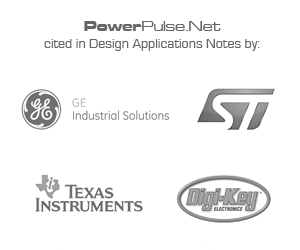STLUX385A: A Revolution for Lighting Digital Controller

Light Emitting Diode (LED) technology has been the most disruptive to the lighting industry in the nearly 80 years since the high pressure sodium vapor lamp was invented in the mid -1930s. LED is attractive not only because of its high efficacy, long life, and reputation for being environmentally neutral, but also because it is much easier to control than florescent or high-intensity discharge (HID) lamps.
Light Emitting Diode (LED) technology has been the most disruptive to the lighting industry in the nearly 80 years since the high pressure sodium vapor lamp was invented in the mid -1930s. LED is attractive not only because of its high efficacy, long life, and reputation for being environmentally neutral, but also because it is much easier to control than florescent or high-intensity discharge (HID) lamps.
“Digital” controllers have been into the mainstream in the realm of power conversion. In many situations, microcontrollers are used for power supply sequencing and tracking, sensing and protection, and communication. But those do not equate to real digital control, but rather digital sensing and power management. Only when the control loop is implemented digitally, it is a real digital controller. The classic digital control block diagram is showing in figure 1.

Figure 1: classic digital controller
This classic approach digitizes the conventional analog process. It ensures good regulation and stable operation of the power converter. But it comes at the cost of complex calculations performed by a powerful µC or DSP to match the dynamic performance of analog controller. Usually all mathematic transfer function calculation is applied in Z-domain, which put high demands on the processing capability of the digital controller. Also, the digital implementations require new expertise, while stability criteria of control laws for analog control as understood by the analog designer are not directly applicable to the digital controller. Therefore, the classic digital controller comes at a higher cost, and a longer development cycle is required to build up the expertise.
STMicroelectronics approaches digital control in a non-conventional way. An innovated state machine concept is used to control the power converter. The switch in the converter is driven by the events, current, voltage or timer. Transfer function computation is no longer needed. The concept is implemented in a block called State Machine Event Driven (SMED). Each state machine has four possible states, and is driven by a 96MHz clock. Each state machine can choose one of three inputs as a condition to make a state transition. Figure 2 shows the block diagram.

Figure 2: SMED block diagram
The diagram below in figure 3 is an example of a transition mode constant on time PFC Boost using the state machine (SMED).

Figure 3: State Machine Event Driven (SMED) based Boost PFC

Figure 4: State transition for constant “on time” Boost PFC
There are four states in total: S0, S1, S2, and S3. Idle state is a transition state during power on. After power reset, it transitions to state S0, the minimum on time state. In this state, S0, the gate signal is High, which means the MOSFET is turned on. The internal timer will count the on time. After minimum on time (Ton-min) passes, it transitions to state S1, normal on time state. In this state, the gate signal will stay High for Ton if the operation is normal. If there is any over current situation before Ton is finished, the event 0 (over current from current sensing IS) can trigger the transition of state to S2, minimum off time state. In the transition, the gate signal is Low, which means the MOSFET is turned off. After minimum off time passes, it will transition to normal off time state, S3. In this state, either zero crossing signal(ZCD) or the max off time can trigger the transition from S3 to S0. This state machine transition will continue repeatedly by itself without intervention from the micro.
The SMED is clocked at 96MHz, it can handle fast current loop. Thanks to the state machine, complex mathematic calculation is no longer needed. Because SMEDs are so flexible, designers can define the states as they want according to a control algorithm. They can control any topology: Boost, Buck, Half Bridge, and Full Bridge converters.
The concept of SMED to control power converters revolutionizes digital control for power conversion. In fact, a SMED based device, the STLUX385A, received an innovation award in CES 2014.
The STLUX385A integrated 6 SMEDs with a low cost 8-bit micro. The low cost micro can perform low speed control function, sensing, and communication. The block diagram of STLUX385A is shown in figure 5.

Figure 5: Block diagram of STLUX385A
A 100w LED streetlight reference design based on STLUX385A was created. In this reference design, the STLUX385A device handles a primary-side regulated power-conversion stage, as well as all the supported communication links. The power-conversion stage consists of a PFC regulator followed by a Zero Voltage Switching (ZVS) LC-resonant stage. High-precision dimming is controlled using a primary-side regulation (PSR) control technique.
The demonstration board provides all the key physical-communication interfaces such as DALI (Digital Addressable Lighting Interface), insulated 0-10 and UART, with all the communication managed by the STLUX385A device. The flexibility of the STLUX385A also allows the board to be easily connected to other interfaces such as Wi-Fi, power-line modems, Bluetooth® and ZigBee®.
The STLUX385A is the world’s first universal digital controller for lighting and power-conversion applications. It opens the way to cost-effective, energy-efficient lighting systems in the home, in the office, and on the street.
Reference:
Ericsson Digital Power Compendium, www.digitalpowercompendium.com
STLUX385A datasheet, www.st.com
STEVAL-ILL066V1, 100 W LED street lighting evaluation board using STLUX385A, www.st.com
























